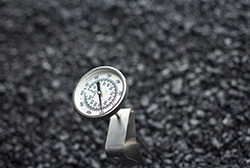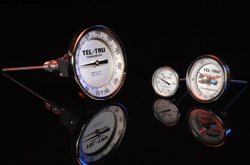
Quality Check
Industry best practices include measuring the temperature of the pad before every stage of the rolling process to ensure proper compaction can be achieved. Logging the data provides the ability to prove the quality of your work and effectiveness of your processes.
Click on the links below to see products recommended for your application.
Please refer to your local and state guidelines to ensure all quality and safety regulations are met.
| Thermometers for Quality Checking Compaction - Temperature Check of Pad | View specs and purchase | ||
|---|---|---|---|
| Dial Thermometers | |||
50/500°F |
GT100R 1-3/4" dial, 5" stem, .150" diameter pointed, 50/500°F with pocket sheath | 16100564AFEADAA | $42.49 |
| GT100R 1-3/4" dial, 8" stem, .150" diameter pointed, 50/500°F with pocket sheath | 16100864AFEADAA | $42.49 | |
50/500°F |
LT225R 2" dial, 5" stem, .150" diameter pointed, 50/500°F | 23100564AFEADAA | $47.13 |
| LT225R 2" dial, 8" stem, .150" diameter pointed, 50/500°F | 23100864AFEADAA | $47.13 | |
| If you don't see what you're looking for, click here to configure other options. | |||
When temperatures are too high or too low
| Consequences: | Potential Costs: |
|---|---|
|
|
Quality
The final pad temperature check should performed just prior to the roller performing compaction. If the pad is too hot the material will spread out too thin and will not compact to the correct thickness causing "waves" in the area. If the pad is too cold, the roller will have little to no effect on creating a smooth surface. Eventually the material will fracture and cause major holes in the pad that will need to be repaired.
Summary of Important Temperature Ranges
Rolling should be completed before the surface temperature of the mix falls below 250°F for proper compaction.- If the pad is too hot when rolling starts the HMA can form buckles, or waves and fan out across the surrounding area. The material will not reach desired thickness and will not last the desired road life expectancy.
- If the pad cools too quickly before rolling, compaction will not happen and the layers of the pad will not adhere to each other creating uneven surfaces.
- Finish rolling should be accomplished at a mix surface temperature above 175°F.
- Failure to roll and compact the pad in these temperature parameters can result in improper installation.
| RETURN TO ASPHALT PAVING OVERVIEW | |
| Asphalt Plant | Quality Check |
| Transportation | Replacement Thermometers |
| Paving, Sealing, and Repairs | OEM Equipment |


